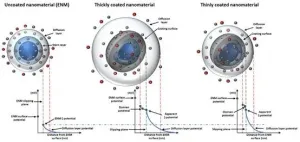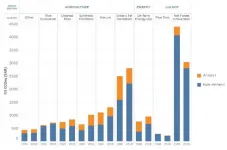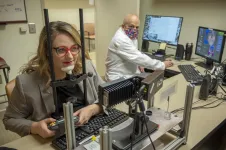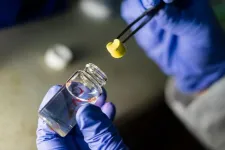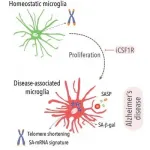(Press-News.org) COLUMBUS, Ohio - Astronomers have taken a big step forward in understanding the dark and violent places where stars are born.
Over the past five years, an international team of researchers has conducted the first systematic survey of "stellar nurseries" across our part of the universe, charting the more than 100,000 of these nurseries across more than 90 nearby galaxies and providing new insights into the origins of stars.
"Every star in the sky, including our own sun, was born in one of these stellar nurseries," said Adam Leroy, associate professor of astronomy at The Ohio State University and one of the leaders of the project.
"These nurseries are responsible for building galaxies and making planets, and they're just an essential part in the story of how we got here. But this is really the first time we have gotten a complete view of these stellar nurseries across the whole nearby universe."
The project is called PHANGS-ALMA, and the research was possible thanks to the ALMA telescope array high in the Andes mountains in Chile.
ALMA, the most powerful radio telescope in the world, is an international facility with heavy U.S. involvement led by the National Science Foundation and National Radio Astronomy Observatory.
The power of this facility allowed the team to survey the stellar nurseries across a diverse set of 90 galaxies, while previous studies had mostly focused only on an individual galaxy or a part of one galaxy.
"When optical telescopes take pictures, they capture the light from stars. When ALMA takes a picture, it sees the glow from the gas and dust that will form stars," said Jiayi Sun, an Ohio State PhD student who is completing a dissertation based on the survey this month.
"The new thing with PHANGS-ALMA is that we can use ALMA to take pictures of many galaxies, and these pictures are as sharp and detailed as those taken by optical telescopes. This just hasn't been possible before."
The survey has expanded the amount of data on stellar nurseries by more than tenfold, Leroy said. That has given astronomers a much more accurate perspective of what these nurseries are like across our corner of the universe.
Based on these measurements, they have found that stellar nurseries are surprisingly diverse across galaxies, live only a relatively short time in astronomical terms, and are not very efficient at making stars.
The diversity of these stellar nurseries came as something of a surprise.
"For a long time, conventional wisdom among astronomers was that all stellar nurseries looked more or less the same," Sun said.
"But with this survey we can see that this is really not the case. While there are some similarities, the nature and appearance of these nurseries change within and among galaxies, just like cities or trees may vary in important ways as you go from place to place across the world."
For example, nurseries in larger galaxies, and those in the center of galaxies, tend to be denser and more massive, and much more turbulent, he said. Star formation is much more violent in these clouds, findings suggest.
"So the properties of these nurseries and even their ability to make stars seem to depend on the galaxies they live in," Sun said.
Results from the survey also showed that these stellar nurseries live for only 10 to 30 million years, which is a relatively short time in astronomical terms. And the team used the same measurements to gauge how efficiently these stellar nurseries turned their gas and dust into stars - and it turned out they weren't that efficient.
"This survey is allowing us to build a much more complete picture of the life cycle of these regions, and we're finding they are short-lived and inefficient," Leroy said.
"It's not random chance destroying these nurseries, but the new stars that they make. They are very ungrateful children."
The radiation and heat that come out of these young stars begins to disperse and dissolve the clouds, eventually destroying them before they can convert most of their mass.
After more than five years of observations, the survey was recently completed and summarized by the PHANGS-ALMA team in two recent papers accepted to the Astrophysical Journal Supplement Series.
The publication of these two new papers marks a milestone, and the data collected by the project team is now publicly available. The researchers have already used PHANGS-ALMA to produce more than 20 scientific publications. Ten papers detailing the outcomes of the PHANGS survey are being presented this week at the 238th meeting of the American Astronomical Society.
"We have an incredible dataset here that will continue to be useful," Leroy said. "This is really a new view of galaxies and we expect to be learning from it for years to come."
INFORMATION:
Contact: Adam Leroy, Leroy.42@osu.edu
Written by Jeff Grabmeier, 614-292-8457; Grabmeier.1@osu.edu
Researchers from the University of Arizona will present findings from radio-astronomical observations of organic molecules at the 238th Meeting of the American Astronomical Society, or AAS, during a press conference titled "Molecules in Strange Places" at the 238th AAS Meeting on Tuesday, June 8, at 12:15 p.m. EDT.
A team led by Lucy Ziurys at the University of Arizona reports observations of organic molecules in planetary nebulae in unprecedented detail and spatial resolution. Using the Atacama Large Millimeter Array, or ALMA, Ziurys and her team observed radio emissions from hydrogen cyanide (HCN), formyl ion (HCO+) and carbon monoxide (CO) in five planetary nebulae: M2-48, M1-7, M3-28, K3-45 and K3-58.
The ...
Researchers have developed a 'library of properties' to help identify the environmental impact of nanomaterials faster and more cost effectively.
Whilst nanomaterials have benefited a wide range of industries and revolutionised everyday life, there are concerns over potential adverse effects - including toxic effects following accumulation in different organs and indirect effects from transport of co-pollutants.
The European Union H2020-funded NanoSolveIT project is developing a ground-breaking computer-based Integrated Approach to Testing and Assessment (IATA) for the environmental health and safety of nanomaterials.
Over ...
A new global analysis says that greenhouse-gas emissions from food systems have long been systematically underestimated--and points to major opportunities to cut them. The authors estimate that activities connected to food production and consumption produced the equivalent of 16 billion metric tons of carbon dioxide in 2018--one third of the human-produced total, and an 8 percent increase since 1990. A companion policy paper highlights the need to integrate research with efforts to reduce emissions. The papers, developed jointly by the UN Food and Agriculture Organization, NASA, New York University and experts at Columbia University, are part of a special issue of Environmental Research Letters on sustainable food systems.
The Center on Global Energy ...
Stereotypes are knowledge structures integrated in our world representation, which have an influence on our decisions and which are hard to change. A team from the Faculty of Psychology of the University of Barcelona (UB) and the Bellvitge Biomedical Research Institute (IDIBELL), in collaboration with the Èpica Foundation - La Fura dels Baus analysed how a performing experience could have a positive impact in reducing the population's bias against physical illnesses. This performing experience is a pioneer one for it combines scientific training and theatre performance in the same working platform.
The study, published in the journal Frontiers in Psychology, shows that the participation ...
After looking for just one-twentieth of a second, experts in camouflage breaking can accurately detect not only that something is hidden in a scene, but precisely identify the camouflaged target, a skill set that can mean the difference between life and death in warfare and the wild, investigators report.
They can actually identify a camouflaged target as fast and as well as individuals identifying far more obvious "pop-out" targets, similar to the concept used at a shooting range, but in this case using easy-to-spot scenarios like a black O-shaped target among a crowd of black C shapes.
In fact, the relatively rapid method for training civilian novices to become expert camouflage breakers developed by Medical College of Georgia neuroscientist ...
Medics training to be GPs reported positive improvement in burnout and resilience after completing a mindfulness course specially designed for doctors
The participants in the study by Warwick Medical School also saw improvements in their wellbeing and stress
By improving the mental wellbeing of trainees the researchers hope to better prepare them for the challenges of general practice and the impact of Covid-19 on the profession
Supports the wider adoption of mindfulness in medical training and the need for larger studies
Medics training to become general practitioners reported a significant positive improvement in their mental wellbeing after participating in a specially-designed mindfulness programme, a study from University of Warwick researchers ...
HOUSTON - (June 8, 2021) - A simple chemical process developed at Rice University creates light and highly absorbent aerogels that can take a beating.
Covalent organic frameworks (COFs), crystal structures with strong molecular bonds, can form a porous aerogel for use as a custom membrane in batteries or other devices or as an absorbent to remove pollutants from the environment.
Conventional COFs are usually powders. Chemical and biomolecular engineer Rafael Verduzco, lead authors and Rice graduate students Dongyang Zhu and Yifan Zhu and their colleagues at Rice's Brown School of Engineering discovered a way to synthesize COF aerogels that can be made in any form ...
Listed by the World Health Organization among the ten leading causes of medical disability worldwide, the severity of obsessive-compulsive disorder (OCD) is at a level on par with cancer. This prevalent disorder is characterized by highly distressing intrusive thoughts and repeated compulsive behaviours such as washing or checking.
"Inadequately treated OCD can rapidly deteriorate to disability for many persons and can negatively impact every sphere of life including school or work, basic self-care and care of children, and psychosocial functioning," says clinical psychologist and internationally renowned expert in OCD and related disorders Dr. Debbie Sookman, who is an Associate Professor in the Department of Psychiatry ...
The promotion and marketing of unproven stem cell therapies is a global problem that needs a global solution, say experts in a perspective published June 8 in the journal Stem Cell Reports. The authors of the paper call for the World Health Organization (WHO) to establish an advisory committee on regenerative medicine to tackle this issue and provide guidance for countries around the world.
"The field of regenerative medicine, which entails the manipulation of cells and tissues to obtain therapeutic properties, has been hailed as the most promising research field in modern medicine," says senior author Mohamed Abou-el-Enein, the executive director of the joint University of Southern California/Children's Hospital of Los Angeles Cell Therapy Program. ...
A new study has pinpointed a small group of cells in the brain which could be crucial to understanding how Alzheimer's disease begins and how to slow its progression. This discovery could help research into treatment for the disease by focusing on this key group of cells in the brain.
Alzheimer's disease is the most common type of dementia, affecting between 50 and 75 per cent of those diagnosed. There are currently around 850,000 people with dementia in the UK. This is projected to rise to 1.6 million by 2040.
"Alzheimer's disease evolves over decades but we currently lack an understanding of the events that take place in the early stages," explained Dr Diego Gomez-Nicola of the University of Southampton ...
